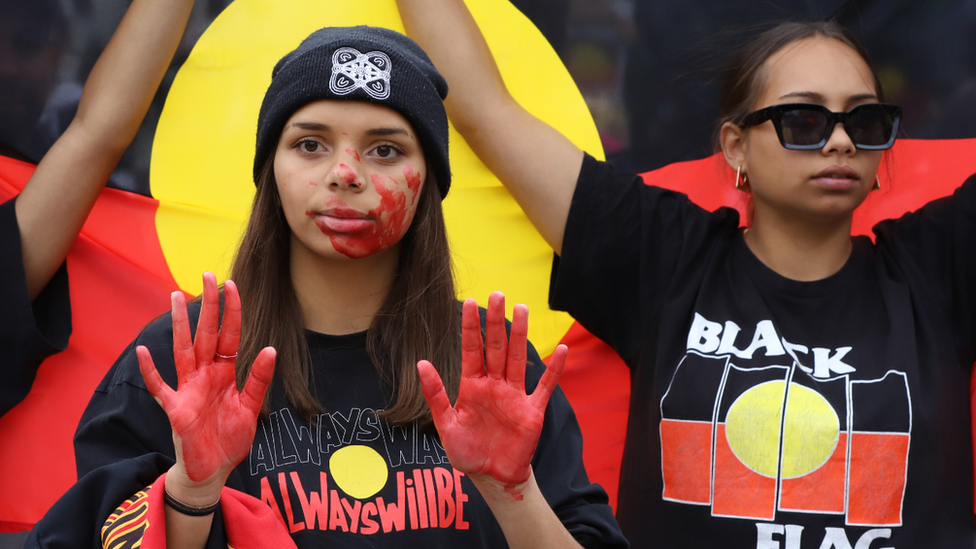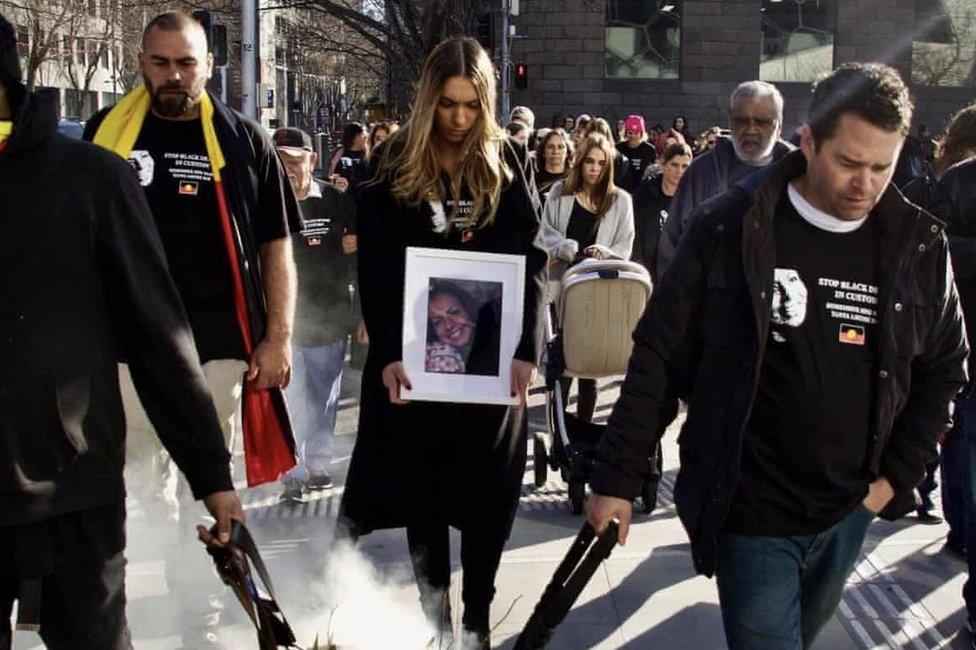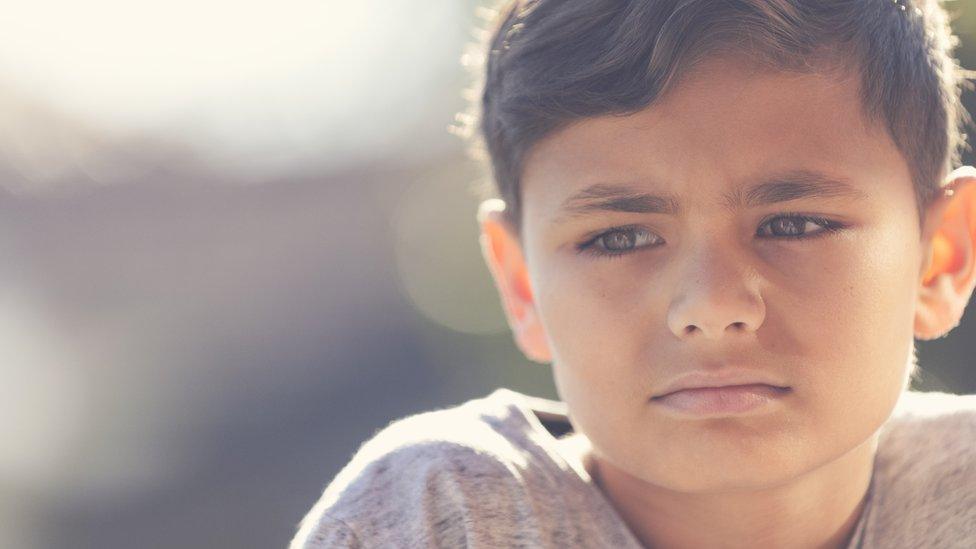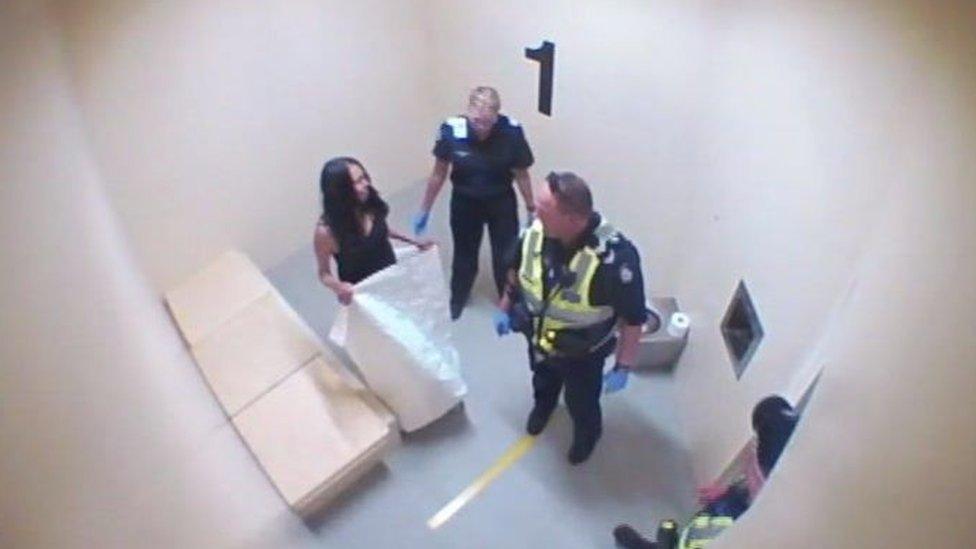Why Aboriginal people are still dying in police custody
- Published

Aboriginal people have the highest rate of incarceration of any group in the world
Aboriginal man David Dungay Jr died in a Sydney prison cell in 2015 after officers restrained him to stop him eating biscuits. During the struggle, he was pinned face-down by guards and jabbed with a sedative.
Video later shown at his inquest captured his final moments: his laboured breathing and muffled screams under the pack of guards.
"I can't breathe," he yelled repeatedly.
His case has parallels to that of African-American man George Floyd, whose death triggered global protests against racism and policing in the US.
The Black Lives Matter movement also threw a spotlight on Australia's own incarceration of indigenous people and their deaths in custody.
This week marks 30 years since a landmark inquiry into Aboriginal deaths in custody. The royal commission made hundreds of recommendations to address the crisis.
But three decades on, the situation has worsened.
Central to the problem is overrepresentation. Indigenous people are about 12 times more likely to be in custody than non-indigenous Australians.
That reality, a product of systemic problems and disadvantage faced by Aboriginal people, has prompted fresh anger over a lack of action.
"The system is continuing to kill us and no one's doing anything about it," Paul Silva, the nephew of David Dungay Jr, said at a rally this week.

Paul Silva says his family has battled for justice for five years
"When will the killings stop? When will the systemic racism stop against First Nations people?"
How many indigenous people have died in custody?
Since 1991, at least 474 Aboriginal people have died in custody. This includes five deaths in the past month.
While indigenous people don't die at a greater rate than non-indigenous prisoners, they are much more likely to be in prison or police lock-up to begin with. That was the finding of the 1991 inquiry, and has continued to this day.
Aboriginal people have the highest rate of incarceration of any group in the world. Roughly half of all juvenile prisoners are indigenous.
Many are in custody without having been sentenced - they may have been taken to a police cell for the night, or may not have money to post bail.
Can the police be blamed for deaths?
Currently, there are three criminal trials of police officers in separate cases who are alleged to have killed an Aboriginal person.
But these are rare prosecutions, the first since the 1980s.
Deliberate violence, brutality or misconduct by police and prison officers is not the main reason so many Aboriginal people have died in custody. This is illustrated in a Guardian Australia database, external tracking all deaths since 1991. The royal commission also found no evidence of police foul play in the 99 cases it examined.
But it didn't excuse officers of culpability.
It found that authorities had "less dedication to the duty of care owed to persons in custody" when they were Aboriginal.
So, what else is to blame?
In many cases, black people have died in Australian cells due to systemic neglect.
Most Aboriginal deaths in custody are due to inadequate medical care, lack of attention and self-harm.
The Guardian database shows indigenous people are three times less likely to receive medical care than others.
Both the commissioners 30 years ago and advocates today say that racist attitudes and assumptions drive this neglect and inaction. They argue racism leads to police officers ignoring cries for help from sick Aboriginal prisoners, or taking too long to attend to their medical needs.
Take the case of Nathan Reynolds, who died in 2017 from an asthma attack after prison guards took too long to respond to his emergency call.
A coroner last month ruled his death was preventable and the "unreasonable delay" deprived him some chance of survival.
His family say officers "stereotyped him as a drug user because he was black and in jail".
The officers didn't care, they say.
"Corrective officers walked to Nathan, they did not run. They took 11 minutes to arrive while our brother's life hung in the balance."
The family of Tanya Day also say racist attitudes led to her death.
She died from head injuries in a police holding cell in 2017, just hours after being arrested on a train for public drunkenness.
A coroner found her cries for help were ignored by police at the station. She should not have have been arrested in the first place, the coroner said, noting that "unconscious bias" led to her being taken into custody.
"Knowing that our mum died in police custody because she was an Aboriginal woman is extremely hard," her daughter, Apryl Day, said.

Apryl Day holds a picture of her mother Tanya at a protest march last year
She told the BBC that after her mother was taken in, the same officers later that day attended a call-out for a heavily drunk white woman.
"But instead of arresting her and fining her like they did my mum, they drove that woman home. They didn't even fine her," she said.
"That woman is alive and well today and our mum is not."
What action is being taken?
The government says most of the 339 recommendations made by the royal commission have been fully enacted, but this is strongly rebuffed by its political opposition and activists.
The inquiry recommended incarceration should only be used as a last resort. Mandatory detention for minor offences should be abolished, along with raising the minimum age of imprisonment. It said states should set up sobering-up shelters to bring people to instead of prison cells.
But the inquiry also outlined how historical dispossession of indigenous people had led to generational disadvantages in health, schooling and employment. These gaps create situations where indigenous people face the police, courts and prison system.
Three decades on, little progress has been made.
Generations of protest: ‘Why I’m fighting for my uncle Eddie Murray'
Indigenous people now make up around 30% of the prison population.
Aboriginal lawmakers this week have called for leadership, including crisis talks between federal and state governments. They also want a formal reporting system on Aboriginal deaths in custody.
The government has scarcely commented on the anniversary of the inquiry this week, and did not respond to questions from the BBC.
It has a target to reduce the rate of indigenous incarceration by 15% by 2031. But its own data shows they're not on track, external to meet this goal unless drastic action is taken.
The opposition Labor party has pledged A$90m (£50m; $69m) to reduce indigenous incarceration.
Still, many are unconvinced that the political will exists to fix the problem.
"Here we are today, still losing our loved ones in the same manner, suffering the same trauma that prompted the royal commission," said Apryl Day.
She and other bereaved families have been campaigning for months to meet Prime Minister Scott Morrison on the crisis, with no luck.
"Our lives are ignored in this country. It's just a constant cycle of violence being perpetrated," Ms Day said.
Related topics
- Published16 June 2020

- Published13 February 2020

- Published27 August 2020
